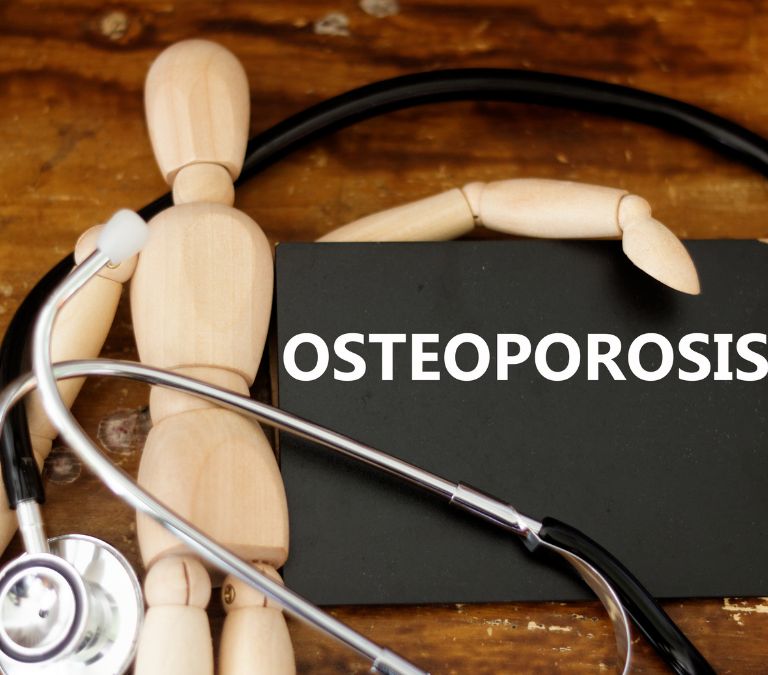Bisphosphonates are drugs used to treat osteoporosis and other conditions related to the bone. Bisphosphonates can help menopausal women deal with this common problem owing to the increased risk of menopausal women developing osteoporosis.
During menopause, the ovaries cease to produce eggs and, in most cases, hormones. As a woman approaches perimenopause, the functionality of the ovaries decreases gradually, and with this, important sex hormones like estrogen, progesterone, and testosterone, produced majorly by the ovaries, go through abrupt decline.
Due to the fluctuations of hormones caused by ovarian failure, menopausal women are exposed to various diseases of varying severity. Menopause is a compulsory phase, and every woman must go through it. However, its symptoms and complications have made this phase fearful for many women worldwide.
Some common menopausal symptoms triggered by hormone fluctuations include hot flashes, night sweats, osteoporosis, sleep disruption, fatigue, depression, anxiety, bloating, urinary incontinence, and vaginal dryness.
The symptoms of menopause can affect several aspects of life. Vaginal dryness affects sex life. It causes sleep disruption, fatigue, low productivity, depression, and anxiety. All these affect mental health. Generally, every menopausal symptom leads to changes in lifestyle for menopausal women. While menopause is not a disease, its symptoms have made many people believe otherwise.
Many menopausal women today live normal lives with very few complications. However, many other women go through the most. Studies have shown that hormone fluctuations caused by menopause are one of the reasons more women than men suffer from diseases like memory loss, cardiovascular diseases, osteoporosis, depression, anxiety, and osteoarthritis. Of the many symptoms of menopause, osteoporosis could be devastating and highly toxic to many women’s productivity and day-to-day activities.
Menopause and Osteoporosis

Osteoporosis is a condition of the skeletal system capable of causing low bone mineral density and high deterioration of bone tissues. The effects of osteoporosis on bone health can lead to an increased risk of fractures due to the increased fragility of the bones. In simpler terms, people with osteoporosis are more likely to fracture their bones from engaging in activities that ought to be tolerable for the bones.
To understand osteoporosis better, you can envision the bones as a sponge. Sponges with wider pores are easier to compress than sponges with small pores. Osteoporosis makes the bone like a sponge with wider pores, making it easier to fracture.
The effects of osteoporosis could be fatal; so fatal that just coughing could lead to a fracture. With the dangers of osteoporosis, one may wonder how fluctuating hormones could trigger a condition as severe as this. The links between fluctuating hormones and osteoporosis are, however, not far-fetched.
How Menopause Causes Osteoporosis
Several factors cause osteoporosis. For this reason, scientists have been unable to define or associate osteoporosis with an exact cause. However, a decrease in estrogen hormones has been identified as a cause of osteoporosis. Osteoporosis in women is, in most cases, caused by menopause.
Estrogen, a female sex hormone, is very useful for regulating bone mass. In women, estrogen plays an important role as the main influencer in the bone-formation process. In the body, the osteoblasts and the osteoclasts are the main cells involved in bone formation and resorption.
By regulating the activities of these cells, estrogen facilitates normal bone health. It means that when the estrogen level in the body is altered, the development of bone-related conditions is very likely. Unfortunately for menopausal women, the decline in estrogen is a characteristic feature of menopause. For this reason, more women have osteoporosis than men.
In most women, the peak of their menopausal symptoms is experienced during perimenopause (i.e., the irregular menstruation period just before menopause becomes confirmed). However, the lasting and persistent structure of osteoporosis has made it more common during postmenopause (i.e., the later stages of menopause when it becomes impossible to get pregnant).
Bisphosphonate Therapy for Menopause
Bisphosphonates are the most common treatment options for postmenopausal osteoporosis. In the United States, about 15 million prescriptions of bisphosphonates are administered yearly. It means bisphosphonates are the primary or first-line therapy for postmenopausal osteoporosis in the United States. Bisphosphonates have been proven efficient enough to prevent or manage osteoporosis by prohibiting bone resorption.
As stated earlier, the osteoblasts and osteoclasts are the major cells involved in bone formation and resorption. The osteoclasts help with bone resorption, while the osteoblasts help bone formation. The osteoclasts and the osteoblasts work hand-in-hand, and any slight imbalance can jeopardize bone health.
For the maintenance of the typical human skeletal structure, bone remodeling is crucial. Bone remodeling involves the breakdown and the rebuilding of bone tissues. Without remodeling, the bone wouldn’t be able to repair itself, an ability important for maintaining bone structure.
When bisphosphonate drugs are taken into the body, they go into the bones and cause the death of many osteoclast cells. The bisphosphonate molecules go into bone tissues and then into osteoclasts. After a series of mechanisms, the bisphosphonates distort the ability of the osteoclasts to break down bones, rendering the osteoclast cells useless.
With more osteoblasts in the body, bone loss is greatly reduced, and the problem of osteoporosis is effectively managed. In most postmenopausal women, osteoporosis is amplified in the hip and spinal region. Studies have shown that long-term use of bisphosphonates in postmenopausal women can prevent fractures and increase bone mineral density’s effects for as long as 5 years. When treated with bisphosphonate drugs, patients have experienced a gradual or sharp decrease in fractures accompanied by increases in bone mineral density.
Dosage of Bisphosphonate Drugs

The dosage of bisphosphonates depends on the type being administered. Here are some types of bisphosphonates and how they are administered:
Alendronate
Also known as Fosamax, alendronate is taken orally and can be taken daily or weekly, depending on the doctor’s prescription.
Risedronate
Also known as Actonel, risedronate, like alendronate, is taken orally, and the doctor makes a prescription.
Ibandronate
Also known as Boniva, ibandronate is injected every three to four months.
Zoledronic Acid
Also known as Reclast, zoledronic acid is injected into the body once a year or sometimes to manage osteoporosis and once in two years to prevent osteoporosis.
Pamidronate
Pamidronate, also known as Aredia, is injected into the body every three to four months.
Hormone Therapy for Osteoporosis
Hormone therapy involves the injection of artificial hormones into the body to help relieve menopausal symptoms. Due to the effects of declining hormones on osteoporosis, injecting more hormones into the bloodstream could alleviate several menopausal symptoms. Many menopausal women with osteoporosis have reported positive results in their bone health after taking hormone therapy.
While hormone therapy is very effective for menopausal symptoms, several risks have been associated with it. For example, long-term use of certain forms of hormone therapy could cause problems as severe as incidental hypertension and cancer.
Due to the risks involved in hormone therapy, many women today have resorted to alternatives to help them with their menopausal problems. It is important, however, to speak to a doctor and know what is best for you before trying out any medication for your menopausal symptoms.
Non-pharmacological Treatment of Osteoporosis
In most cases, doctors recommend bisphosphonates as the primary option for treating postmenopausal osteoporosis. However, both pharmacological and non-pharmacological treatment options are recommended by many doctors to get optimal satisfaction. In some cases, bisphosphonate drugs take time to show significant improvements.
In some other cases, patients are skeptical about using certain medications. While bisphosphonates remain the most effective treatment for postmenopausal osteoporosis, doctors can recommend alternatives in certain cases. Some non-pharmacological management options for postmenopausal osteoporosis include:
Exercise and Physical Activities
Studies have shown that active engagement in physical activities can be quite effective for managing osteoporosis. Exercises for managing osteoporosis are divided into two; weight-bearing aerobic activities and Strength training exercises.
Weight-bearing Aerobic Exercises
These exercises involve using the legs, arms, and feet to support your weight. Exercises like these are usually easy and do not require sophisticated equipment. Engaging in these exercises aims to slow down the bone mineral loss. Some weight-bearing aerobic exercises include walking, dancing, and stair climbing. Active engagement in these activities can strengthen your bones and muscles and train them to stay tough.
However, it is important to know that rigorous or high-impact activities like running and jogging can worsen the problem. Generally, postmenopausal women with osteoporosis shouldn’t engage in convulsive exercises involving rapid movements and high energy as they can lead to more fractures. Instead, consider exercising with slow and regulated movements. Consistently engaging in these exercises can go a long way in developing healthy bones.
Strength training Exercises
Exercises like these involve the use of free weights in a bid to strengthen muscles and influence good posture. In most cases, the muscles targeted in strength training exercises are the spinal muscles. By training the spinal muscles, good posture is attained. For osteoporosis patients, good posture is important to maintain balance and not fall. Falling can lead to even more fractures which can be excruciating to bear. Strength training exercises can also help maintain tolerable bone density.
Before engaging in strength training exercises for menopause, it is important that you follow a bearable weight and not go beyond what your bones can lift. Lifting heavy weights can twist the spine and lead to more severe complications. In most cases, a therapist, personal trainer, or even a doctor will help with the provision of the best routines to help you combat this problem.
Diet and Supplementation
Diet options and specific supplements can also help women with osteoporosis manage it better. Generally, supplements like calcium, vitamin D and K, boron, magnesium, zinc, and copper can help maintain healthy bones and, as such, are used to manage osteoporosis better.
Studies have shown that foods like fruits, veggies, fatty fish, low-fat milk, meat, and beans can help relieve postmenopausal osteoporosis.
FAQs on Bisphosphonates for Menopause
Will bisphosphonates hurt my bones?
In rare cases, bisphosphonate recipients have reported a crack in the middle of the thigh bone. While this situation is usually rare, it is possible. In other scenarios, bisphosphonate recipients have reported cracks in their jawbones that often take a long time to heal. Only a few people report these situations, and most of these cases are triggered by underlying medical conditions.
What are the side effects associated with the use of bisphosphonates?
Bisphosphonates’ side effects include fever, bowel movement changes, joint pain, nausea, irritation, and tiredness. These side effects are associated with all bisphosphonate medicines.
Are bisphosphonate drugs FDA-approved?
Yes, bisphosphonate drugs are FDA-approved. Unlike many other treatment options for osteoporosis, bisphosphonate drugs are scientifically-backed and have shown significant results after administration. Patients are advised not to self-medicate as a qualified medical practitioner will prescribe bisphosphonate drugs.
Do I need to engage in exercises while taking bisphosphonate drugs?

Bisphosphonate drugs have proven to be effective. However, it is not advisable to depend solely on medications for optimal results. Postmenopausal women with osteoporosis who receive bisphosphonate drugs are advised to also engage in exercises and other physical activities permissible for weak bones to get the best result.
How long does it take to see results?
In most cases, it takes between 3 and 4 months to see the result of treatment with bisphosphonates. For this reason, the time frame for seeing results can vary from one woman to another.
Can osteoporosis get better on its own?
No, osteoporosis cannot get better on its own. Instead, it will worsen over time. It is important to follow every proven treatment option and specific guidelines designed by doctors to prevent osteoporosis from worsening.
Can bisphosphonates make my condition worse?
In most cases, bisphosphonates improve bone health and help with osteoporosis. However, few people have reported severe reactions like cracks in the thigh bone and the jaw region. While this is true, most people who have reported not-so-good reactions to bisphosphonate drugs have underlying conditions like cancer.
Can I get bisphosphonate drugs over the counter?
Yes, bisphosphonate drugs are very accessible. Because they are FDA-approved, purchasing one shouldn’t be a problem. Bisphosphonates are bought online as well.
Are bisphosphonate drugs more effective than hormone therapy?
No, bisphosphonate drugs aren’t as effective as hormone therapy. Hormone therapy is a general treatment for menopausal symptoms. While hormone therapy has been very effective in treating many menopausal symptoms, you can’t compare its effectiveness to bisphosphonates. Due to the risks and side effects involved in the use of hormone therapy, many women have resorted to the use of bisphosphonates to help with osteoporosis.
Conclusion
Even with the many complications, menopause is not a disease. For this reason, women must take charge of this compulsory phase to live a healthy life. Osteoporosis and other problems related to the bone can be fatal. While osteoporosis is more common in women, science has introduced more treatment and management options, making the menopausal journey easy for many women. Take the management of menopausal symptoms seriously. After all, we owe life to ourselves to live it.







